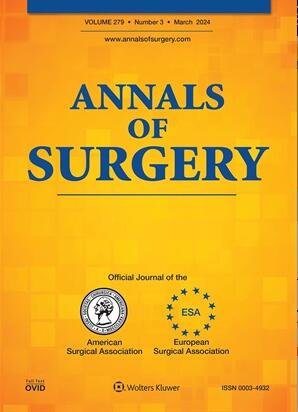110,000 Preventable Deaths: The Most Impactful Gaps in Firearm Suicide Prevention Laws 2010-2019.
IF 7.5
1区 医学
Q1 SURGERY
引用次数: 0
Abstract
OBJECTIVE We sought to identify which absent firearm laws would have prevented the most firearm suicides (FS) in each state of the US. SUMMARY BACKGROUND DATA Prior studies suggested efficacy for FS prevention varies greatly between different firearm laws. However, this body of work did not probe how this efficacy may differ by state. METHODS This state-level, retrospective cohort study of firearm laws among the contiguous United States from 2010-2019 used Poisson models for the association between state FS per 100,000 population and implementation of state firearm laws lagged by 7 years, spatially weighted total firearm laws in surrounding states, and state demographics. These models were applied to each absent law in each state to estimate the reduction in FS associated with law implementation. The law associated with the greatest reduction in each state was the most impactful missing law. RESULTS Eight of 12 law categories were significantly associated with decreased FS rates. The largest associated reductions in FS were with child access prevention, or CAP (IRR 0.53; 95% CI 0.48-0.59; P<0.001), and concealed carry permitting, or CCP (IRR 0.59; 95% CI 0.54-0.65; P<0.001). Five states had all law categories for the study duration, and CAP and CCP were the most impactful missing law categories in 22 (51%) and 9 (21%) of remaining states, respectively. A total of 114,106 FS were associated with all states not having implemented their most effective missing law category across the study period. CONCLUSIONS This study found that FS rates in most states would have decreased most with passage of CAP or CCP, which can inform policymaking in respective states.11万例可预防的死亡:2010-2019年枪支自杀预防法律中最具影响力的差距。
目的:我们试图确定在美国各州,哪些枪支法律的缺失会阻止最多的枪支自杀(FS)。背景资料先前的研究表明,不同的枪支法预防FS的效果差异很大。然而,这项工作并没有探讨这种功效如何因州而异。方法:本研究对2010-2019年美国相邻州的枪支法律进行了州级回顾性队列研究,使用泊松模型分析了每10万人口中州的枪支法律与滞后7年的州枪支法律实施之间的关系,以及周边州的空间加权枪支法律总量和州人口统计学。这些模型应用于每个州的每个缺席法律,以估计与法律实施相关的FS减少。各州减少最多的法律是最具影响力的缺失法律。结果12个法律类别的权利与FS率的降低有显著相关。FS的最大相关降低与儿童获取预防(CAP)相关(IRR 0.53;95% ci 0.48-0.59;P<0.001),允许隐蔽携带,或CCP (IRR 0.59;95% ci 0.54-0.65;P < 0.001)。五个州在研究期间拥有所有法律类别,CAP和CCP分别是其余22个州(51%)和9个州(21%)中最具影响力的缺失法律类别。在整个研究期间,所有未实施其最有效的缺失法律类别的州共有114,106个FS。结论:本研究发现,随着CAP或CCP的通过,大多数州的FS率下降最多,这可以为各州的政策制定提供信息。
本文章由计算机程序翻译,如有差异,请以英文原文为准。
求助全文
约1分钟内获得全文
求助全文
来源期刊

Annals of surgery
医学-外科
CiteScore
14.40
自引率
4.40%
发文量
687
审稿时长
4 months
期刊介绍:
The Annals of Surgery is a renowned surgery journal, recognized globally for its extensive scholarly references. It serves as a valuable resource for the international medical community by disseminating knowledge regarding important developments in surgical science and practice. Surgeons regularly turn to the Annals of Surgery to stay updated on innovative practices and techniques. The journal also offers special editorial features such as "Advances in Surgical Technique," offering timely coverage of ongoing clinical issues. Additionally, the journal publishes monthly review articles that address the latest concerns in surgical practice.
 求助内容:
求助内容: 应助结果提醒方式:
应助结果提醒方式:


